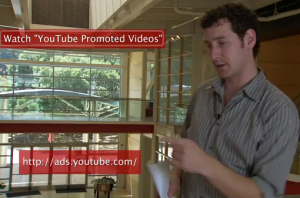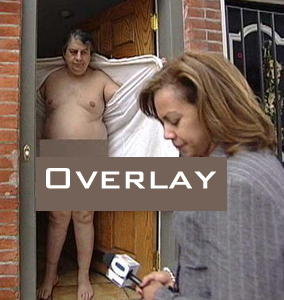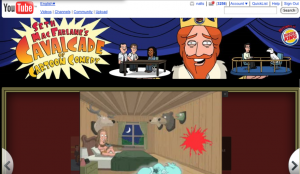Yes. Video prerolls are both growing and declining. The good news for viewers is that we saw fewer prerolls. But we saw more “polite prerolls” (option to escape) in Q1 2011 as reported by AdoTube/eMarketer. Since this doesn’t include YouTube data and presumably a small sample of total online-video ad streams it does need to be taken with a grain of (Morton’s: when it rains it pours!) salt.
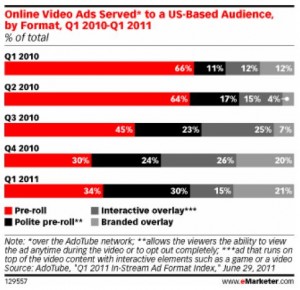
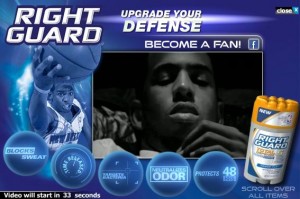
Forget prerolls, friends. The increasingly competitive ad networks have a whole sleuth of weapons in their online-video ad formats that range from the innocuous “polite pre-roll,” to a bit more ominous names like in-stream takeover, ad selector, in-stream skin, inside-out roll, interactive overlay, video-in-video, interactive gaming overlay, data entry and capture, branded player, over the top, and beyond stream. I believe that Seroquel example, placing a “reminder” ad without “fair balance” adjacent to depression content is (shhh) a violation of FDA guidelines, but I digress. ANY of these ad-format names beats the “fat boy” branded by Point Roll.
Take a look at some of the bold “engagement” formats presented in AdoTube’s ad-format gallery and you’ll see why viewers are, according to eMarketer, about 30% likely to engage in an ad… even when not forced (hence the term “polite”). You’ll also see that it’s often not clear there’s an opt-out available.
The eMarketer report, titled “Options for Online Video Ad Viewers Leads to Higher Engagement” is encouraging. With online video being one of the leading (if not #1) fastest-growing portion of a marketer’s “media mix,” advertisers will want and expect formats that achieve their goals: from branding to engagement. This chart is important to viewers because it shows that “cost per impression” remains the dominant percent of spending. In “cost per impression” (often called CPM, or cost-per-thousand), the advertiser simply pays a few bucks to reach 1,000 eyeballs without much accountability.
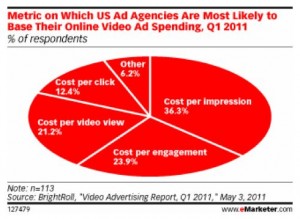
While few of us welcome more aggressive online-ads, this also substantiates a business model to fuel the medium’s growth. While it’s easy to complain about intrusive ads (especially as the pendulum seemed to swing dangerously to the advertiser’s benefit in the past year), it’s a vital element to online-video’s maturity. If the advertisers don’t get what they need, friends, we won’t be seeing our content for free.
There are three ways to increase “engagements” in this online-video advertising medium, and I’ll list them from best to worst in order of sustainability: novelty, creative and targeting:
- Novelty: A new ad format generally enjoys a period of high engagement that’s deceptively high. We’re curious about what the ad does, and may not realize we’re engaging, so it’s not necessarily suggestive of purchase intent. In early February, a debut YouTube customer of YouTube’s “skip this ad in x second” preroll told ClickZ he was seeing a 30% engagement rate. That’s far higher than we’ll see as a norm, and a tribute to the novelty effect.
- Creative: Great creative always wins, and this is a fairly enduring trait. While overall engagement might slip when we’re “numb” to an ad format (like monkey-shooting banner ads, or even the “InVid” format that creeps up on YouTube… the best creative wins the best attention, engagement and results.
- Targeting: Ultimately the most sustainable and important characteristic of a high-engagement online-video ad is its ability to reach the right target. I can engage in a tampon ad, but it’s not going to sell more maxi’s. But if I get a rich-media ad over (or adjacent) to my valued content, then we’ve got a win-win-win (advertiser, publisher, viewer). That’s where we can expect Google/YouTube to be better in the long haul, but it appears the sophisticated advertiser networks are ahead. These ad networks marry data from a variety of sources to serve ads invisibly on the videos across a variety of websites.
So what are the takeaways to advertisers, video sites and us viewers?
- First, the options available to advertisers means that online-video ads will begin to get as aggressive as other forms of interactive ads. This has positive and negative effects, but as long as it’s targeted it’s sustainable.
- YouTube, which reports very little about its ad performance, has not radically departed from its debut formats, with the exception of breaking its early commitment to make pre-rolls optional. Now most pre-rolls are mandatory, but we can opt-out of some after a few seconds (at which point the “opt-out” means the advertiser pays YouTube and the creator less).
- Ads are a vital cost-offset for those of us that have been enjoying free video content for 5 years and would like that to continue without avoid pesky Hulu-like subscription models (unless a “value ad” bonus to the cable contract, assuming we haven’t “cut chord.”).
- And finally, Morton’s salt can be trusted. Trusted I say.

